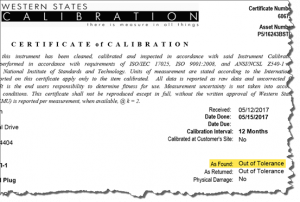The concept of traceability of measuring equipment to an international standard to assure confidence of measurement results has been part of quality systems since the original Mil-Q-9858 in the 1950’s. Most organizations refer to this as “calibration”. The concept is to make sure all the equipment you use to measure your product related standards must be traceable to NIST to assure that all organizations measure using the same reference standards. Obviously it is important that when we measure an inch you get the same result as your customer.
Clause 7.1.5.2 in AS9100D describes the requirement:

There are many other requirements like a register, recall method and the organization shall determine the validity of previous measurements when the equipment is found unfit for its intended use. The last item is the focus of this tip.
It is very common to find equipment “As Found: OOT” when performing the comparison to a standard for measurement traceability (commonly referred to as calibration). “As Found: OOT” means that when the equipment was compared to a standard it was found out of tolerance (OOT). When this happens the AS9100D standard has a very specific requirement:

Here’s what the “As Found: OOT” looks like on a certification (this particular certificate is from Western States Calibration in Salt Lake City):

One of the most common findings in an AS9100D audit is not meeting the requirement to take action based on the “As Found” condition. Be sure that your system requires you to take action when equipment is found out of tolerance or when equipment is taken out of service. The action is usually to create an internal corrective action.
In the corrective action you must determine if the previous measurements are valid since the equipment was found out of tolerance.
When you take equipment out of service be sure to measure it against a standard using a valid process to determine the “As Found Condition”. If it is found OOT you must take the same action you take when the equipment is “As Found OOT” when being measured against a standard (commonly called calibration).
